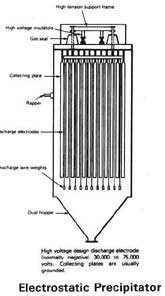File:Electrostatic p.jpg
Electrostatic_p.jpg (165 × 296 pixels, file size: 8 KB, MIME type: image/jpeg)
| This is a file from the Wikimedia Commons. Information from its description page there is shown below. Commons is a freely licensed media file repository. You can help. |
Summary
| DescriptionElectrostatic p.jpg | English: See dust collector Electrostatic Precipitators use electrostatic forces to separate dust particles from exhaust gases. A number of high-voltage, direct-current discharge electrodes are placed between grounded collecting electrodes. The contaminated gases flow through the passage formed by the discharge and collecting electrodes. The airborne particles receive a negative charge as they pass through the ionized field between the electrodes. These charged particles are then attracted to a grounded or positively charged electrode and adhere to it. The collected material on the electrodes is removed by rapping or vibrating the collecting electrodes either continuously or at a predetermined interval. Cleaning a precipitator can usually be done without interrupting the airflow. The four main components of all electrostatic precipitators are:
The following factors affect the efficiency of electrostatic precipitators:
| |||||||
| Date | Unknown | |||||||
| Source | Chapter 4: Collecting and Disposing of Dust. OSHA / US Department of Labor.
| |||||||
| Author | Unknown US government | |||||||
| Permission (Reusing this file) |
| |||||||
Licensing
| Public domainPublic domainfalsefalse |
This work is in the public domain in the United States because it is a work prepared by an officer or employee of the United States Government as part of that person’s official duties under the terms of Title 17, Chapter 1, Section 105 of the US Code. Note: This only applies to original works of the Federal Government and not to the work of any individual U.S. state, territory, commonwealth, county, municipality, or any other subdivision. This template also does not apply to postage stamp designs published by the United States Postal Service since 1978. (See § 313.6(C)(1) of Compendium of U.S. Copyright Office Practices). It also does not apply to certain US coins; see The US Mint Terms of Use. |  | |
| This file has been identified as being free of known restrictions under copyright law, including all related and neighboring rights. | ||
https://creativecommons.org/publicdomain/mark/1.0/PDMCreative Commons Public Domain Mark 1.0falsefalse
Original upload log
Upload date | User | Bytes | Dimensions | Comment
- 2006-02-16 18:53 (UTC) | Ignaciomella | 8170 (bytes) | 165×296 | Electrostatic Precipitators Electrostatic Precipitator Electrostatic Precipitators use electrostatic forces to separate dust particles from exhaust gases. A number of high-voltage, direct-current discharge electrodes are placed between grounded collecti
Captions
Items portrayed in this file
depicts
16 February 2006
File history
Click on a date/time to view the file as it appeared at that time.
| Date/Time | Thumbnail | Dimensions | User | Comment | |
|---|---|---|---|---|---|
| current | 10:51, 14 September 2011 |  | 165 × 296 (8 KB) | SreeBot | (Original text) : Electrostatic Precipitators Electrostatic Precipitator Electrostatic Precipitators use electrostatic forces to separate dust particles from exhaust gases. A number of high-voltage, direct-current discharge electrodes are placed betwe |
File usage
The following page uses this file:
Metadata
This file contains additional information, probably added from the digital camera or scanner used to create or digitize it.
If the file has been modified from its original state, some details may not fully reflect the modified file.
| _error | 0 |
|---|


 French
French Deutsch
Deutsch